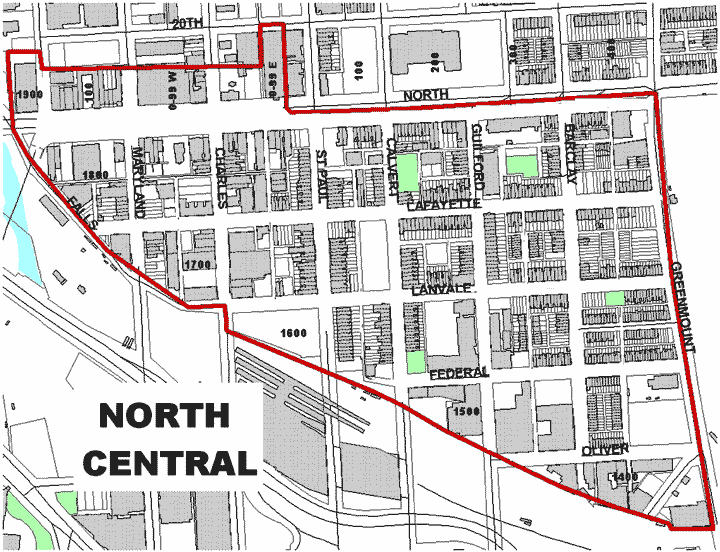North Central
National Register of Historic Places 12/27/02
Description
 The North Central Area is comprised of twenty-five city blocks directly north of downtown Baltimore. The area stands at the crossroads of major north-south streets leading from downtown (Charles Street, St. Paul, Calvert Street, Maryland Avenue, and Guilford Avenue) and a major east-west thoroughfare, North Avenue. The roughly triangular-shaped, mixed-use district comprises late 19th century row housing, commercial storefronts from the turn of the century until the 1950s, large industrial buildings, as well as several old theaters, a church, and two school buildings. Most of the 630 buildings in the area are 2-4 story high row houses; however, the area also features an eight-story former apartment complex, several multi-story industrial/warehouse structures, and a few one-story, late 20th century automobile-oriented commercial buildings.
The North Central Area is comprised of twenty-five city blocks directly north of downtown Baltimore. The area stands at the crossroads of major north-south streets leading from downtown (Charles Street, St. Paul, Calvert Street, Maryland Avenue, and Guilford Avenue) and a major east-west thoroughfare, North Avenue. The roughly triangular-shaped, mixed-use district comprises late 19th century row housing, commercial storefronts from the turn of the century until the 1950s, large industrial buildings, as well as several old theaters, a church, and two school buildings. Most of the 630 buildings in the area are 2-4 story high row houses; however, the area also features an eight-story former apartment complex, several multi-story industrial/warehouse structures, and a few one-story, late 20th century automobile-oriented commercial buildings.
Urban in character, the North Central District includes examples Queen Anne, Romanesque, Neo-classical, Spanish Revival, and Modern style architecture in regards to its commercial and industrial structures. The residential buildings and houses which define the eastern portion of the area range from traditional Baltimore row houses with flat brick facades and restrained decorative treatments to more highly embellished eclectic designs built with a variety of materials. Some streets are tree-lined, but landscaped parks are rare, and parking lots and vacant lands where housing formerly stood create gaps within the district. Still, the majority of streetscapes are intact, retaining a high degree of historic integrity.
Significance
The North Central neighborhood is architecturally significant in that it embodies the distinctive characteristics of a late-nineteenth century to mid-twentieth century mixed-use, urban neighborhood, comprising a variety of row houses and other commercial/industrial buildings. The majority of its buildings represent the evolution of row housing from the traditional to more eclectic varieties which housed not only noteworthy Baltimore residents (including poet Sinclair Lewis) but also working class African-Americans living in small alley quarters.
The North Central Area is also significant because of its association with important businesses and industries, both local (such as Morgan Millwork) and national (such as the Noxell Company and Crown Cork and Seal). The neighborhood remained an important multifunctional area for Baltimore City until the post World War II period, when many people moved to the suburbs and businesses closed. Located within a corridor of historic neighborhoods in central Baltimore (Mount Vernon, Charles Village, Guilford, Homeland, and Roland Park), the North Central District completes a relatively unbroken chain of historic districts reflecting the migration of wealthy Baltimore residents from downtown to the northern suburbs.